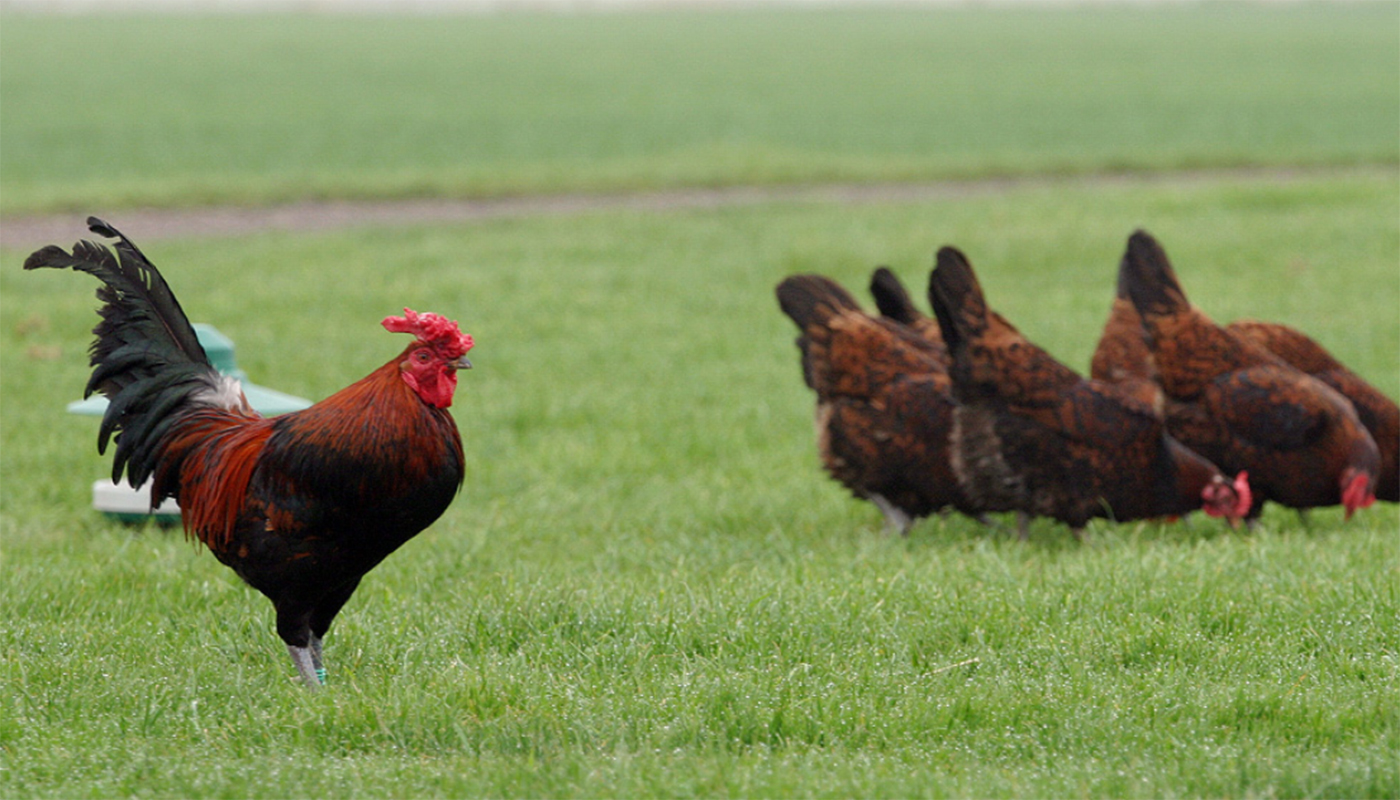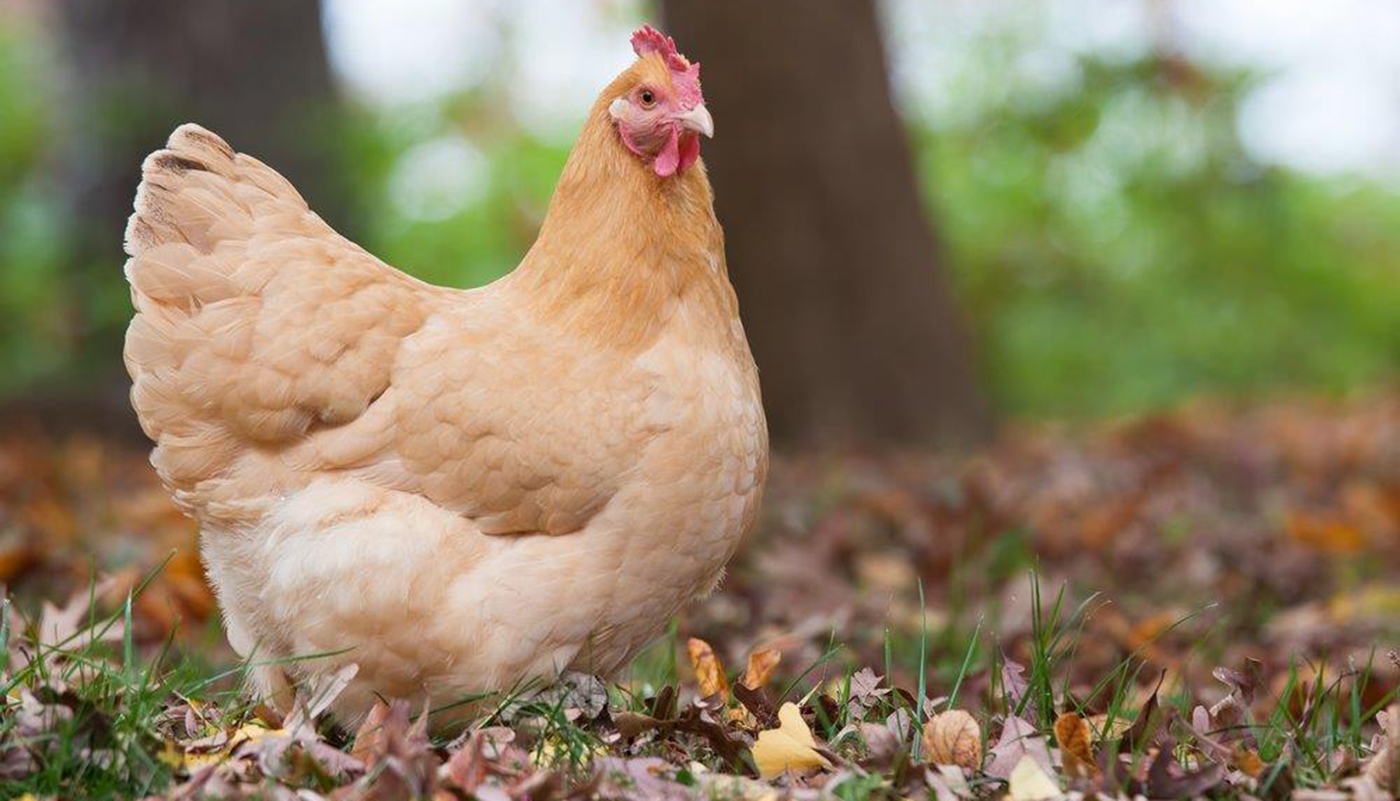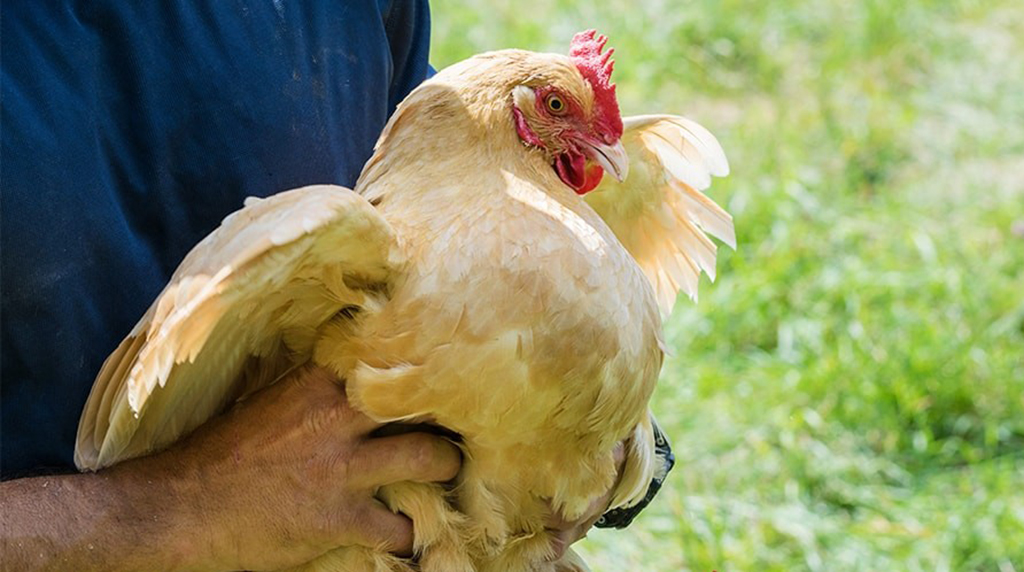
The Lakenvelder is also known as “Shadow on Sheet” because of their feathers which are said to resemble a black shadow on a white board.
It is a domesticated breed of chicken that comes from Nordrhein-Westfalen area of Germany and along/over the borders of The Netherlands.
Once a popular dual-purpose bird revered for its pristine white eggs and very tasty tender white meat.
The breed was popular during pre-war Europe during which and after its number declined.
The Lakenvelder is quite rare in America and mainly kept as a pet, for its eggs and as a show bird.
They are very active and alert birds that are great foragers and free-range chickens. Their alertness gives them a better chance at avoiding prey and the expert foraging abilities make them a bit easier on the chicken feed.
| Country of Origin: | Germany |
| American Poultry Association: | Yes – They are recognized as a breed of chicken in the United States Admitted to the Standard of Perfection in 1939 |
| Chicken Category: | Large Breed |
| Chicken Class: | Continental |
| Bantam Variety Available? | Yes – Single Comb Clean Legged Bantam Classification |
| Good Starter Chicken? | Yes |
IDENTIFICATION⇒ |
Appearance/Body: The Lakenvelder hens combs are unique in that they stand straight up.
These chickens have the most beautiful black and white plumage. Their tails, hackles and heads are black. The rest of their body is mostly white soft feathered. They have bright red earlobes, combs, wattles and eyes. They have clean slate-blue legs with four toes.
Color(s) Silver
Comb: They have a single, 5-pointed comb
Ave. Weight: Pullet: 3.5 lbs.
Hens: 4 lbs. Cockerel: 4 lbs. Rooster: 5 lbs. |
PURPOSE⇒ |
Eggs: They are very good egg layers.
They lay medium to large porcelain white eggs They lay 130 – 170 eggs per year They will lay consistently throughout the year although egg production may slow down during the colder months They start to lay eggs from around 22 weeks old.
Meat: They have white skin
Their carcasses may not be too fleshy, but they still produce the most delectable tender meat that made it once a very popular table bird in its country of origin
Breeding: They can be bred but breeding these chickens is not advisable for the novice.
The hens do not get broody They are not brood hens They are not sitters Incubators or brood hens may be required They will raise their chicks but are not very good mothers It may be best to include a motherly breed that is known to foster other hens/breeds chicks
Show Bird: Their plumage which is said to resemble a black shadow on a white board give these birds a unique edge and thus they make an excellent show bird. Their grand plumage and very upright proud posture make them a prize bird.
Pets: They tend to shy away from humans but if raised correctly from hatchlings they can be tamed although it is unlikely they will lose their flighty finicky nature.
Other: A great showpiece to compliment your flock with its outstanding plumage and offer a heap of fresh white eggs for your table.
|
CHARACTERISTICS |
|
|---|---|
| Life Expectancy: | The average lifespan is 6 – 8 years some chickens live longer depending on their environment |
| Health: | They have no known health issues and are quite a hardy breed |
| Temperament: | Flighty, active, alert and weary. They tend to be shy of humans and most other animals. |
| Flyers? | They can fly quite well so it may be an idea to clip their wings if you live in a built-up area and do not want them to fly the fence. |
| Noisy Birds? | Can be a bit noisy and the rooster’s crow is quite loud |
| Interaction with other chickens: | They will eventually get used flock members but will take their time getting to know newcomers. They are not aggressive towards other chickens and the roosters can be a bit protective over his flock. |
| Good with kids? | No, due to their skittish flighty natures they are not the best breed to have around children. |
| Socialize Behavior? | They tend to avoid other animals until they are used to them |
| Known predators: | Always keep an eye on domestic pets such as dogs and cats. If hawks and or foxes are in your area it is always best to take precautions. Check with local animal shelters, zoos, vets, animal control and or pet stores about common predators in your area. |
| Conservation Status: | These birds conservation status is recorded as “threatened”. |
IDEAL ENVIRONMENT |
|
|---|---|
| Garden Size: | They do not do well in confinement A larger garden, homestead or farm is better suited to the Lakenvelder. They love to forage and free-range eating their fresh findings of the day. |
| Ideal Climate: | Warmer Climates They tolerate heat well but still need shady spots and lots of cool water in the heat. They are not cold hardy and may need extra warmth in the winter in form of heating lamps. Ensure their roosting area is not drafty and that they have nice cosy nesting boxes with plenty of straw to nestled down in. |
| Ideal Coop: | The rule of thumb for any coop is 50 cm x 50 cm per hen/rooster in the coop. Ensure there is a good space for the nesting boxes and nightly roosting rails at least 1.5 inches wide. Good ventilation for air but not too drafty especially in winter. It is always a good idea to raise the coop off the ground to give the birds a dry place to roost and lay especially in wet weather. |
| Ideal Coop Run: | Lakenvelder will need a full covered coop run. |
| Ideal Flock Size: | They are quite happy in any size flock as long as they have a companion or two |
| Special Instructions: | They may have special breeding instructions for show birds. They are quite self-sufficient chickens that makes them low maintenance and a hardy breed. |
| Accessories: | The following accessories are ideal for your coop: Nesting boxes Straw for the boxes and roosting area Roosting rails Perches Water troughs/bowls Food bowls/feeders Heating lamp(s) Animal carrier for transport purposes |
| You may Also Like: | 45 FREE DIY CHICKEN COOP PLANS, TUTORIALS AND DESIGNS |
WHERE TO BUY THEM |
|
|---|---|
| Live Poultry Outlets: | You could find a few outlets that carry unsexed hatchlings |
| Internet Poultry Websites: | Yes, there are a few reputable internet poultry retailers that sell Lakenvelder |
| Organizations: | American Poultry Association may have registered breeders American Livestock Conservancy may have registered breeders |
| Breeders Clubs: | The Rare Poultry Society may have a list of registered/known breeders |
| Other: | The organizations and or breeders listed above may also have a host of valuable information about your chickens. They will also be able to provide you with any special instructions, problems, etc. about your chickens. |
HISTORY
Lakenvelder is believed to have originated from an ancient Canaanite breed that was found in the Middle East.
The first domestic chickens were brought to Mesopotamia by Indo-Aryan wise men who became known as Ah-Brahman (the Holy Men of Brahmaputra River).
Ah-Brahman settled in a few places such as Tel Megiddo (city of Armageddon) in Palestine. It was here that they took to breeding their fowls putting a value on the roosters for their crowing and the hens their eggs.
The Semites were one of the first people to use eggs for backing and made the very first bagel.
It was the Jewish immigrants that migrated to Germany and Holland brought with their Tel Megiddo chickens with them. It is from these chickens that the Lakenvelder gets its ancient lineage.
The breed as we know it today was bred by the Westfalen Germans and the Dutch between 1727 and 1835. Although they do not have very meaty carcasses their meat is very tasty, and they lay very white medium to large eggs. Thus, they were very popular and used as a dual-purpose bird in pre-war Europe whereby during and after the breeds numbers started to decline.
The breed first arrived in England in the early 1900’s where it was first shown in 1902.
The Lakenvelder also reached America in the early 1900’s where their beautiful unusual coloring made them popular show birds during this time.
The Lakenvelder is not a very popular chicken in the USA and those who do keep them do so for their eggs, as pets or for show only.
NOTES / SPECIAL INSTRUCTIONS
As they are registered as a “threatened” conservation status they may need an extra license to own or keep in your garden. For advice on what the bird’s conservation status and orders are please check with your local conservation department.
For breeders, it is imperative that you always check your bird’s bloodlines and ensure you are buying your birds from a reputed breeder/farm. In order to sell birds of such stature, they have to be recorded and documented, always check with local animal breeding organizations for these records.
These legitimate documents are also required should you wish to show your bird(s) in various poultry shows/competition showings.
For information and advice on adopting rescued animals, you can visit or contact your local animal welfare center.
Video
USEFUL LINKS
- Caring for your Chicken
- Feeding
- Health
- Socializing your Chicken
- Breeding Chicken
- Raising Chickens A-Z
- Hatching Eggs
- What is Molting
- Animal Shelter (ASPCA)
- American Veterinary Medical Association
- American Poultry Association
- American Animal Welfare Society
- American Animal Control
- American Animal Husbandry Society
References
- https://en.wikipedia.org
- https://livestockconservancy.org
- https://www.roysfarm.com
- https://www.mypetchicken.com
- https://www.backyardchickens.com
- https://www.feathersite.com/
 CONDITIONS THAT AFFECT A CHICKENS GUT
CONDITIONS THAT AFFECT A CHICKENS GUT Redcap Chicken Breed – Everything You Need to Know
Redcap Chicken Breed – Everything You Need to Know The Top Chicken Breeds for Egg Laying
The Top Chicken Breeds for Egg Laying Orloff Chicken Breed – Everything You Need to Know
Orloff Chicken Breed – Everything You Need to Know 80+ Best Chicken Coops and Runs to Buy
80+ Best Chicken Coops and Runs to Buy Wyandotte Chicken Breed – Everything You Need to Know
Wyandotte Chicken Breed – Everything You Need to Know Orpington Chicken Breed – Everything You Need to Know
Orpington Chicken Breed – Everything You Need to Know Hamburg Chicken Breed – Everything You Need to Know
Hamburg Chicken Breed – Everything You Need to Know Ayam Cemani Chicken Breed – Everything You Need to Know
Ayam Cemani Chicken Breed – Everything You Need to Know RAISING CHICKENS – A STARTER GUIDE FOR THE FIRST-TIME CHICKEN KEEPER
RAISING CHICKENS – A STARTER GUIDE FOR THE FIRST-TIME CHICKEN KEEPER Common Digestive Disorders in Chickens: Symptoms, Treatment, and Prevention
Common Digestive Disorders in Chickens: Symptoms, Treatment, and Prevention Why Deworming Chickens is Important?
Why Deworming Chickens is Important?